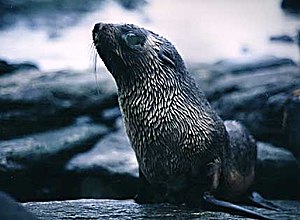Antarctic fur seal
| Antarctic fur seal | ||||||||||||
|---|---|---|---|---|---|---|---|---|---|---|---|---|

Antarctic fur seal, cub |
||||||||||||
| Systematics | ||||||||||||
|
||||||||||||
| Scientific name | ||||||||||||
| Arctocephalus gazella | ||||||||||||
| ( Peters , 1875) |
The Antarctic fur seal ( Arctocephalus gazella ) is a species of the southern fur seal .
Surname
The scientific name gazella is reminiscent of the SMS Gazelle , which brought a scientific expedition to Kerguelen in 1874 to observe the transit of Venus . Wilhelm Peters , the director of the Berlin Zoological Museum , was the first to describe the Antarctic fur seal on the basis of the specimens he brought with him .
features
Bulls reach a head-trunk length of 190 cm, cows 130 cm. The weight is 150 or 50 kg. The coat color is gray-brown. The bull also has a black mane in which many gray or white individual hairs shimmer through. Long whisker hairs ( vibrissae ) grow on the cheeks, the muzzle or around them and possibly over the eyes .
distribution
These fur seals live on islands around the Antarctic . The largest colonies are in South Georgia ; others can be found on Marion Island , the South Shetland Islands , the South Orkney Islands , the South Sandwich Islands , Bouvet Island , Kerguelen , Heard and the McDonald Islands , the Crozet Islands and the Macquarie Island .
Usually Antarctic and Sub- Antarctic fur seals live separately from each other; only on Marion Island and the Crozet Islands do they form common colonies, and there occasional mating between the two species occurs.
Wandering individuals of the Antarctic fur seal are found in considerable numbers on Prince Edward Island and Tierra del Fuego . However, this seal does not form colonies there.
Inventory development
The colonies still comprised several million animals at the end of the 18th century. In the 1790s, the seal hunters' forays began. In the southern summer of 1800/1801 112,000 fur seals were slain in South Georgia alone . On one island after another, the colonies were destroyed and the yield increased. The colonies in the South Shetland Islands were not discovered until 1819; they comprised about 400,000 animals that were wiped out in just two years. In the 1830s the species was considered extinct; However, since such a huge distribution area cannot be completely controlled, Antarctic fur seals have survived mass slaughter in some regions. In the 1930s there was again a colony of a hundred animals on South Georgia. Due to strict protection laws, it grew annually and in the early 1990s again comprised 1.6 million animals. The stock situation is more critical on the other islands of the former distribution area: outside of South Georgia, only 50,000 Antarctic fur seals lived in the same period.
Hazard and protection
The Antarctic fur seal is designated as Least Concern in the Red List of Endangered Species of the International Union for Conservation of Nature ( IUCN ). Nevertheless, like all species of its genus, the species is protected worldwide by trade restrictions in the Washington Convention on the Protection of Species, CITES, Appendix II. This protective measure is included in the European Union with the EU Species Protection Regulation (EC) No. 338/97 and thus automatically extended to all member states of the European Union. The Federal Republic of Germany takes this into account by including it in the Federal Nature Conservation Act and describes this seal as a specially protected species.
additional
The Gazella peak in South Georgia is named after him.
literature
- Ronald M. Nowak: Walker's Mammals of the World . Johns Hopkins University Press 1999, ISBN 0-8018-5789-9 .
- Nigel Bonner: Seals and Sea Lions of the World . Facts on File 1994, ISBN 0-8160-2955-5 .
- Mark Carwardine: Extreme of Nature . NATIONAL GEOGRAPHIC 2005, ISBN 978-3-86690-081-3 .
Web links
- Arctocephalus gazella in the endangered Red List species the IUCN 2009. Posted by: Aurioles, D. & Trillmich, F. (IUCN SSC Pinniped Specialist Group), 2008. Retrieved on January 10 of 2010.
- The CITES Appendices. Retrieved January 10, 2010 (English, The Appendixes of the Washington Convention on Species Conservation, CITES).
- WISIA Tracing Service for Endangered Species. In: WISIA Online. German Federal Agency for Nature Conservation, accessed on January 10, 2010 .